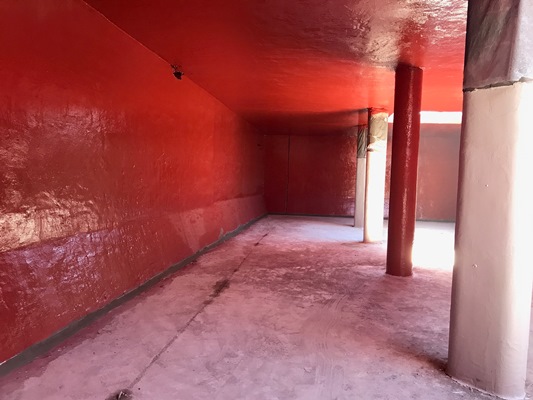Six chambers, 40,000 square feet (3,716.1 m²) total, 65 days. Coating systems that were applied to all walls, columns, and ceilings within the scope of the project. Sounds like a straight forward project, right?
“It seems a lot easier than it was,” explained Carlos Rocha, quality control services (QCS)/manager for Southland Painting Corp. So what was causing the difficulties? “The work itself,” he said. “The environment; it’s not a friendly environment. Odors, heat, cleaning up.” Luckily for the South Florida wastewater plant, which wishes to remain unnamed, the 10-person crew was up to the daunting task.
Check and Go
The six chambers of this project make up what’s called an oxygen train, which allow the waste to flow during the wastewater plant's aeration stage. The concrete surfaces first needed to be assessed, and it was determined that they needed to be blasted first. Using 40,000 psi (275.8 MPa) ultrahigh pressure washers from NLB Corp., the crew divided and conquered: “We had one working the ceiling, one working the wall,” Rocha explained of the crew members’ roles.
Because all of the work was considered confined space, they used personal protective equipment (PPE) and ventilation to keep things moving. “Everybody has respirators and safety glasses and shields,” Rocha said. The respirators were manufactured by 3M, and they also used fresh air. In total, it took the crew about 1.5 weeks per chamber to complete this stage.
This is also where part of the challenging aspect of the job came into play. With power washing comes debris. And with debris comes cleanup. “After we blasted, we had to clean up all the debris,” Rocha explained. They shoveled everything into buckets and then had to “haul” them out into Dumpsters.
During this stage, the project took an unexpected twist. “We encountered more surface prep needed than anticipated, so that took more material, more cement, but it wasn’t an issue,” Rocha explained. “We were still able to finish everything in time. There was not one issue on this job.”

After they started blasting, the crew noticed that there was more to the old coating system than the epoxy liner that the spec showed. There were other types of linings as well, including one that was rubber. “To blast that, it actually [damaged] the concrete,” Rocha said. “Once we removed it, it was rougher concrete than expected.” That meant they’d have to do some concrete repair before they could move on to the new coating system.
But first, the concrete, which Rocha identified as “much deteriorated,” had to be tested for pH. This was one of several tests completed by the city and coating manufacturer throughout the entire project.
Once accepted, the crew moved on to repairing the surfaces of the walls, ceiling, and columns using silicate mortar and Ceramico by Epoxytec. The Ceramico was sprayed
using Graco equipment and back troweled to an average of 3/4 inch (1.9 cm). The crew covered each chamber in about four days.
Once reaching another check point, the crew then moved onto another wash, this time using 3,500 psi (24.1 MPa) pressure washers by Honda. According to Rocha, this is done to “clean up all the stuff from the dust and to ensure that once we apply the final coat, everything is clean.”
Then, after the substrate dried with ventilation, it was time for the final step in the system: Uroflex. Wearing respirators and air monitors, the crew completed the first pass with Graco spray equipment to achieve an average thickness of 20 mils (508.0 microns) in a beige color. The crew came in the next day and applied another layer of approximately 20 mils (508.0 microns) in red. The alternating colors were used to help the crew ensure that there was full coverage.
Safety Approach
The crew took a multi-pronged approach to safety on this project. Not only did they use proper PPE for each step along the way, but they also had a dedicated safety crew member and a retrieval system in place. That meant there was a tripod at one of the openings of each chamber and each crew member wore a harness. “Everybody was wearing a harness at all times so that in case something happens to them we’d be able to connect and pull them up on the tripod,” Rocha explained. There were “no issues” with this or with dehydration, which can be attributed to the crew’s diligence in stopping to drink water.
They were also diligent in the systematic approach to the client’s needs. After the walls and ceiling were sprayed, the crew then worked on the columns. Wearing chemical-resistant gloves, they applied an average of 120 mils (3,048.0 microns) of Epoxytec’s CPP with trowels. “That protects the cement because you have a lot more vibration on the columns,” Rocha explained.
Hard at Work
Despite challenges with prepping the substrate, the crew completed the job on time and without any hiccups. “We didn’t even have a punch list; we didn’t have to go back and fix anything,” Rocha said. “The guys did an awesome job,” he continued. “In my opinion, it’s one of the best jobs that we’ve done so far. The guys did extra work, did extra hard. This crew was one of the best crews that I’ve worked with so far.” Daunting task conquered!
